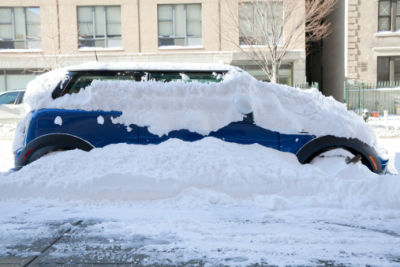


Winter can be brutal, and after heavy storms, especially a string of them, digging your car out can get repetitive and exhausting. Some people throw in the towel and may leave their vehicles covered in snow for weeks. This can cause problems however, and can lead not only to costly repairs but could pose a hazard on the road.
Brake Damage: Leaving snow and ice to build up under and around your car can lead to your brakes rusting. Once you do dig out and drive your car, you might notice squeaking and squealing when you use the brakes. This could be telling you that it is time to visit a mechanic you trust to have a look. It is absolutely a necessity to have fully functioning, well-maintained brakes during winter when road conditions are toughest. Every year poor car and truck maintenance is responsible for accidents on Michigan roads and highways.
Undercarriage Damage: Ice, snow, and salt building up around the exposed undercarriage of your vehicle can cause rust and damage if left untended. Especially if you have an older car, incidents like a muffler falling off are not unheard of, and this is a danger not only to yourself but to others around you.
Tire Damage: When you let a car sit for weeks without moving it in freezing conditions, the tires can develop flats. It is best to try to run your car once a week and get it moving to prevent this. Of course doing so might mean taking the time to remove all the snow from around your car.
 Windshield and Wiper Damage: Everyone knows snow is easiest to remove from the windshield right after it snows. If you leave snow built up on your windshield, and then it rains and refreezes, then you will have ice, not just snow to deal with. Removing ice can be tricky and time consuming. Be careful using a scraper, and try not to scratch up your windshield. Do not pour warm or hot water on the windshield because this could crack the glass. Make sure ice is removed from around your windshield wipers. If you happened to have left the wipers on when you parked, and now they are encrusted in ice, then once you turn the car on, the wiper motor could get damaged if the frozen ice prevents them from moving properly.
Windshield and Wiper Damage: Everyone knows snow is easiest to remove from the windshield right after it snows. If you leave snow built up on your windshield, and then it rains and refreezes, then you will have ice, not just snow to deal with. Removing ice can be tricky and time consuming. Be careful using a scraper, and try not to scratch up your windshield. Do not pour warm or hot water on the windshield because this could crack the glass. Make sure ice is removed from around your windshield wipers. If you happened to have left the wipers on when you parked, and now they are encrusted in ice, then once you turn the car on, the wiper motor could get damaged if the frozen ice prevents them from moving properly.
Also make sure that you have good wipers on your car. Winter conditions can wear them out quickly, and you need them to have the best visibility on the road that you can.
Dead Car Battery: Leaving your car untended to can shorten the lifespan of your battery. It is best to run your car engine at least once a week to exercise it. A dead car battery can leave you stranded on a snowy or icy road, which puts you in danger and can pose a road hazard for others if they do not see your car on the side of the road.
Ice and Snow Around the Exhaust Pipe: If you leave your buried in snow, it is easy for snow and ice to form in and around the exhaust pipe. Every year, too many people die from not properly removing the ice and snow from around the exhaust pipe before running their cars. If the exhaust is blocked, deadly carbon monoxide can build up in the cabin of the car.
Vehicle maintenance needs to happen all winter long, not just in preparation of it. Otherwise, drivers expose themselves, their loved ones, and the public to hazardous situations on the road. Not to mention the extra money it costs to deal with the repairs. Putting in the effort right after it snows, as long as you can do it safely, is best for making sure your car is road ready.
Sachs Waldman helps to get compensation for victims of car and truck accidents, handles no-fault insurance claims, and fights for clients in other personal injury matters in Michigan. If you or a loved one needs to speak with a personal injury attorney, contact our Detroit law firm at (313) 965-3464 or fill out our online form. Consultations are free and confidential.
© 2025 Michigan Injury Attorneys
View Our Disclaimer | Privacy Policy
Detroit Personal Injury & Car Accident Attorneys